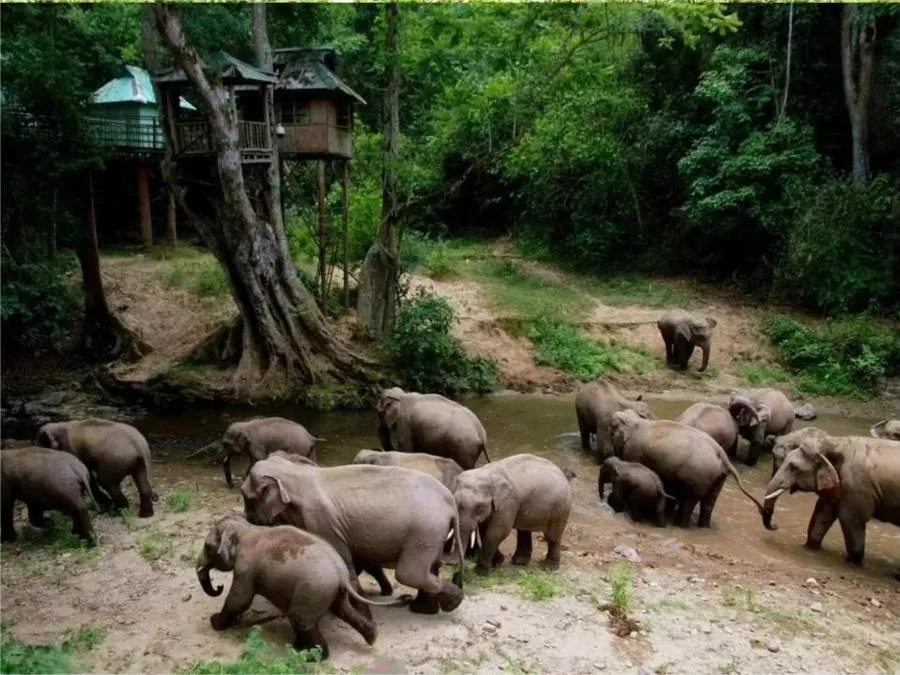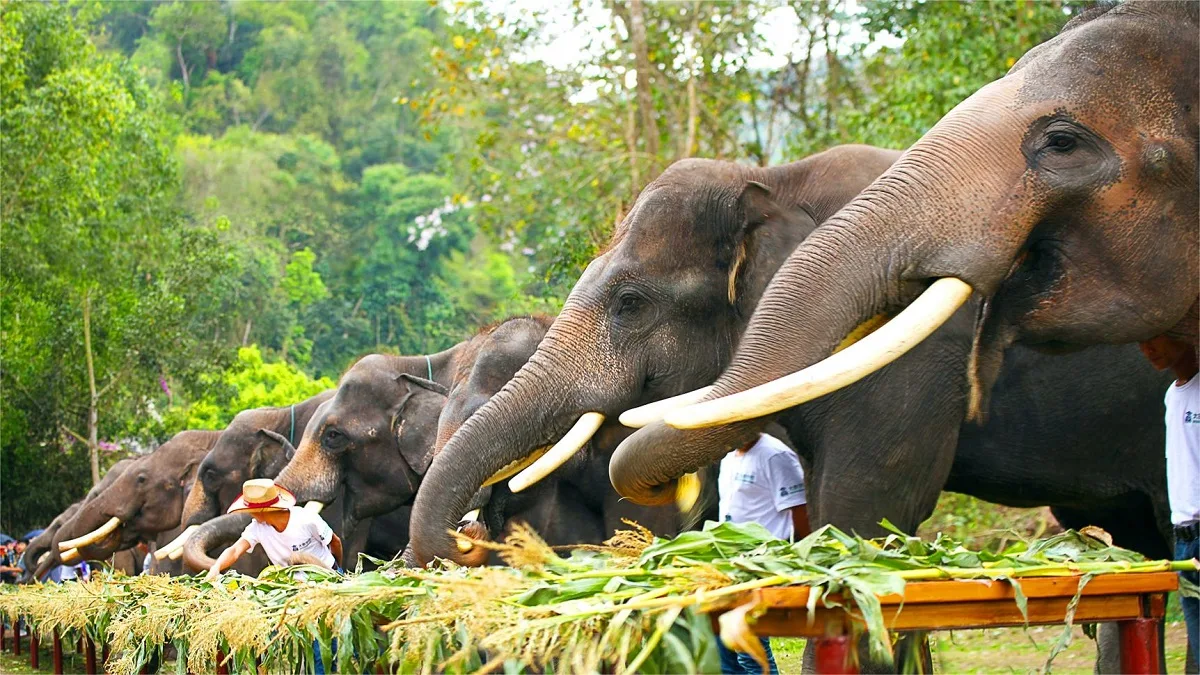Wild Elephant Valley (野象谷), located in the Mengyangzi Sub-reserve of the Xishuangbanna National Nature Reserve, is China’s first national park dedicated to animal and environmental protection. This unique destination allows visitors to safely observe Asian elephants and their habitats through various attractions, including a high-altitude observation walkway, a rainforest sightseeing cableway, the Asian Elephant Museum, an Asian elephant breeding base, and an Asian elephant performance school. These features provide a rare opportunity for close encounters with Asian elephants without disturbing their natural lives, earning the valley the reputation of being a bridge between humans and Asian elephants.
The valley is rich in natural resources, showcasing a diverse array of tropical rainforests, South Asian tropical evergreen broadleaf forests, and numerous rare plant and animal species. As a comprehensive ecological tourism area, Wild Elephant Valley integrates ecological tourism, scientific education, research, and leisure vacationing. It has received multiple prestigious accolades, including being one of China’s first “National Ecotourism Demonstration Areas” and winning the “Golden Award for China’s 50 Must-Visit Places for Foreigners.”
Table of Contents
- Basic Information
- Location and Transportation
- Highlights of Wild Elephant Valley
- Vlog about Wild Elephant Valley
- Other Attractions in Jinghong Suburbs
Basic Information
| Estimated Length of Tour | 3 hours |
| Ticket Price | 60 RMB |
| Cable Car | 50 RMB for one way |
| Opening Hours | 8.00 – 18.00; Last admission: 16.30 |
| Best Time to Visit | March – May & September – November |
| Telephone Number | 0086-0691-2431024 0086-0691-2431040 |
Location and Transportation
Wild Elephant Valley is located in Mengyang Town, Jinghong City, Xishuangbanna Dai Autonomous Prefecture, Yunnan Province, approximately 22 kilometers from downtown Jinghong. Shuttle buses to the valley are available from various bus stations within Jinghong City, and there are also dedicated tourist buses that provide transportation to this popular destination.
Highlights of Wild Elephant Valley
Tropical Rainforest

The tropical rainforest in Wild Elephant Valley features a variety of plant species. Woody lianas traverse the forest layers, some reaching tens of meters high and even breaking through the canopy to form vines. Tall trees host a myriad of epiphytic plants like orchids, while the forest floor is characterized by extensive buttress roots, aerial roots, and prop roots. The phenomenon of strangler figs is common, showcasing the intriguing dynamics of tropical forests. Visitors can explore this vibrant ecosystem via several key attractions:
- Rainforest Sightseeing Cableway: This is the longest tropical rainforest cableway in China, spanning 2,063 meters. It offers a bird’s-eye view of the rainforest, allowing visitors to see the transition from the forest floor to the canopy and beyond.
- High-altitude Walkway: Resembling a vine or rainbow, this elevated walkway allows visitors to walk through the mid-canopy level of the forest, providing a unique perspective of the vegetation.
- Forest Trails: These stone-paved trails wind through the forest floor, giving visitors an intimate look at the diverse understorey vegetation.
Wild Asian Elephants

Wild Elephant Valley is the premier location in China to observe wild Asian elephants, making it a significant highlight. China’s wild Asian elephants are predominantly found in the Xishuangbanna National Nature Reserve, with approximately 150 elephants in the Mengyangzi Sub-reserve and over 70 frequently seen in Wild Elephant Valley. This abundance makes Wild Elephant Valley a unique and exclusive destination for safely observing these magnificent creatures.
The lush, dense primary forest provides an excellent habitat for a variety of wildlife, including the Asian elephants. These elephants move in herds through the forest, primarily active during dawn and dusk, resting in the forest or bathing in streams at midday. Occasionally, they even cross National Highway 213, temporarily halting traffic and allowing for spontaneous viewing opportunities.
To enhance the visitor experience and support conservation efforts, Wild Elephant Valley has set up tree observation houses. These treehouse lodges offer a unique accommodation experience, allowing guests to stay close to the elephants’ natural habitat. This proximity provides an unparalleled opportunity to observe the elephants and other wildlife, while also offering a unique blend of adventure and tranquility.
Butterfly World

Wild Elephant Valley is a haven for butterflies, boasting over 100 species including swallowtails, ringlets, fritillaries, and pierids. These vibrant butterflies are a common sight throughout the year, flitting among the forest, riverbanks, and meadows. A particularly unique sight is the clusters of butterflies attracted to piles of elephant dung, which they feed on. This natural spectacle, set against the backdrop of blooming wildflowers, enhances the valley’s enchanting beauty, making it a true butterfly paradise.
In 1990, the Xishuangbanna National Nature Reserve Administration collaborated with the World Wide Fund for Nature (WWF) to initiate a project on the artificial breeding and rearing of wild butterflies. This led to the establishment of China’s first and largest butterfly breeding base in Wild Elephant Valley—Butterfly Garden. The Butterfly Garden successfully breeds over 40 species of butterflies, amounting to around 150,000 individuals annually. This initiative not only preserves butterfly populations but also offers visitors an up-close experience with these delicate creatures.
Bird Paradise

Wild Elephant Valley is also a sanctuary for bird enthusiasts. The area and its surroundings are home to more than 100 bird species, many of which exhibit striking colors and are characteristic of tropical and subtropical regions. The diversity of bird species, coupled with their vibrant plumage and melodious calls, makes the valley an ideal location for bird watching.
In 1998, the valley established the Bird Garden to showcase the local avian diversity, highlighting the region’s reputation as the “hometown of pheasants.” The Bird Garden houses over 80 species and more than 2,800 birds, creating a vibrant ecosystem where these birds can thrive. It serves not only as a display area but also as a crucial center for the breeding, rearing, and conservation of various bird species.
The Bird Garden has become an educational hub for visitors, promoting awareness and understanding of bird conservation. Through continuous exploration and research, it has developed into a scientific base for the breeding and preservation of birds. This dedication to avian conservation underscores Wild Elephant Valley’s commitment to protecting and showcasing the rich biodiversity of Xishuangbanna.







